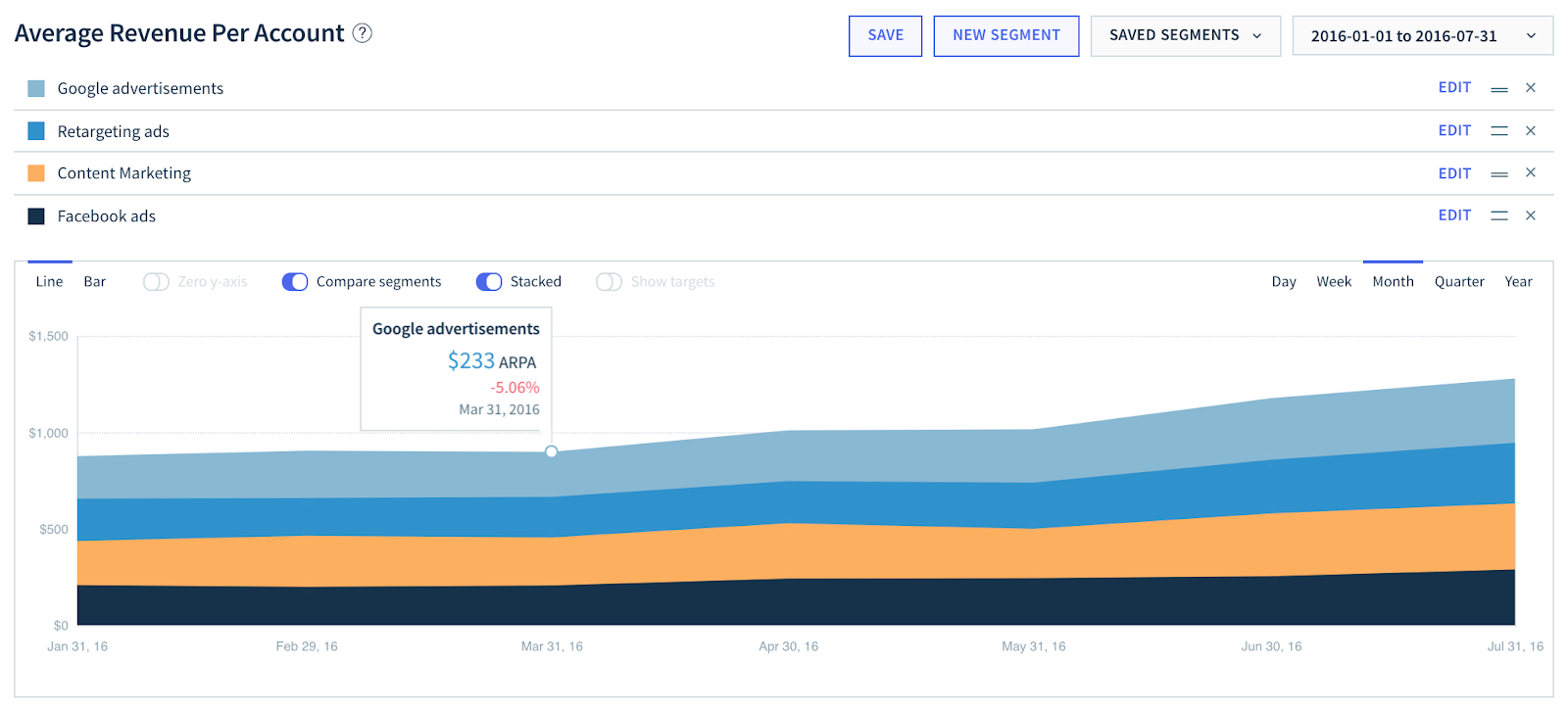At first glance, ARPU looks like a weird metric to track — why should I care about the average customer and the price they pay?
Shouldn’t we be more interested in specific (groups of) customers?
In fact, ARPU (or ARPA, or ARPC) is one of the most important metrics you should be looking at every stage of your company’s journey.
Here’s why.
Note: ARPU (Average revenue per user), ARPA (Average revenue per account), and ARPC (Average revenue per customer) are used interchangeably in the industry.
What is ARPU?
The average revenue per user (or ARPU) is a measure of the amount of money a single customer generates for a company. It is calculated by dividing the total revenue of a business in a given period by the (average) number of customers in that same period.
What is ARPPU?
ARPPU stands for Average revenue per paying user. If your business offers a free tier, your ARPU and ARPPU metrics will differ.
This distinction is important for products that feature a large set of free users and a small group of paying customers who drive the overall profitability of the product. Examples include most mobile games and many lifestyle apps targeted at consumer audiences.
How to calculate ARPU?
Use this formula to find your ARPU:
ARPU = Total revenue in period / # of customers in same period
Note: ChartMogul calculates ARPU automatically when you import your billing data.
It is important to figure out what’s the most relevant time frame to look at when calculating your ARPU. This is an easy task for SaaS businesses that charge a monthly subscription fee — in that case, a month is the most relevant period.
But if you’re only selling annual subscriptions a monthly ARPU might not be the best measure — in that case, you might want to look at your average revenue by quarter or even by year.
The same applies to consumer businesses like Airbnb for example — the typical customer probably doesn’t make a reservation each month, so a quarter would be a much more meaningful timeframe in which to look at the average revenue generated by a customer.
What is included in the ARPU calculation?
ARPU essentially has 2 elements: Monthly Recurring Revenue (MRR) and the total number of customers you have.
But your MRR consists of several elements that you have to consider:
- MRR: This includes customers who signed up in previous periods and continue paying for your product plus any new business which was added in the current time period.
- Upgrades, upsells, and add-ons: People who switch to a higher pricing tier, add additional subscriptions, and/or extra features that are charged separately of their main plan.
- Downgrades: The opposite of the previous elements, those are customers who are now paying a lower monthly rate due to going to a lower pricing tier.
- Churned MRR: These includes the accounts who canceled their subscription during the time period.
Although these are already taken into account when you look at MRR, it is important to keep in mind that they affect your ARPU — taking measures to improve each element can have an effect on the overall metric.
ARPU vs LTV
There’s a bit of confusion when it comes to the difference between the Average Revenue per User and the Customer Lifetime Value (LTV). They’re not the same.
LTV tracks the total amount of money an average customer pays you before they churn. As such, it is a measure of how well you’re retaining customers. This can be a useful indication of whether your marketing department is doing a good job of targeting the best customers and how well your customer success team is doing.
ARPU is a better suited to evaluate the performance of factors such as your pricing, your messaging, and the effectiveness of the channels you’re using to reach customers (more on this below).
What is a good ARPU?
There’s no single answer that can be given here — it all comes down to your business and the niche/industry you operate in.
One way to figure out what a good number is to find the ARPU of your competitors and see how you stack against them.

Another thing you should consider is what customers you’re after — if you’re mostly chasing mice and rabbits, then you can expect to have a lower ARPU.
But if you’re after whales and elephants, then a low ARPU might be a signal that your strategy is not working as intended.
What’s the best way to use ARPU?
ARPU is a great indication for the quality of revenue you’re generating from customers.
There are multiple ways in which you can use it to guide your decision. Here are a few applications for it.
Compare yourself to competitors
ARPU is a quick way to figure out how you’re performing vis-a-vis your peers.
That doesn’t mean that your number should compare directly to that of a competitor — you might be pursuing different strategies and going after different customer segments as a result.
However, if you’re benchmarking yourself against a customer who’s employing a similar approach, ARPU is a great quick way to figure out how you’re performing and take action if necessary.
Improve customer segmentation
The average deal size allows you to split your customer base into segments and analyze how each segment is performing.
For example, you can isolate customers on a free plan and only look at the behavior of those of your customers who are already paying for your solution, thus uncovering important insight about what drives conversions and what makes them happy.
Or you can segment customers between cheaper self-service plans and a higher enterprise tier and analyze their behavior on that basis — how long each deal takes to close, where customers of different sizes fall out, etc.
This can also help you identify new customer groups to focus on and/or find opportunities to optimize your pricing. Maybe you notice there’s a group of clients on the most expensive tier you offer who have very high engagement — because the value they’re getting from your product is very high.
Such insight can be a great starting point to figure out how to organize your pricing around a value metric.
Evaluate acquisition channels
ARPU is a great way to evaluate the effectiveness of each marketing channel you’re using.

Segment customers by the channel they’ve come through and compare the average revenue generated by a customer in each segment.
This is similar to performing a CAC vs. LTV analysis for each channel — insights about channel ARPU can guide your decisions about how much of your marketing budget to invest and what channels to prioritize/scrap.
Assess the quality of the revenue you generate
ARPU can be useful when talking to investors or when analyzing the performance of your business.
Brian Parks from Bigfoot Capital shared with us that ARPU is one of the main metrics his team uses when evaluating opportunities for revenue-based financing.
The dynamics of ARPU is a great indicator for the quality of revenue you’re generating. Most investors would expect to see a positive trend in average revenue, especially for younger companies.
A falling ARPU indicator (especially in more mature companies) might signal trouble ahead.
Forecast revenue
The average sale you generate can also be used for a quick back-of-the-envelope estimation of how much revenue you can expect to generate in a given period.
For example, if you know you’ve brought 500 customers at $100/mo ARPU in the first six months of the year, you can expect to bring just as much in the second half, bringing your MRR to $100,000/mo.
Say your marketing department is planning a big initiative in the second part of the year — using ARPU to quickly estimate how much you should generate without the campaign can help you come up with a reasonable goal for how much new business the campaign should generate.
Keep a close eye on your ARPU metric
The average revenue per user is a key metric for SaaS businesses.
It gives you one of the best ways to quickly understand whether your company is moving in the right direction. It’s a great way to measure the impact of a new strategy or a pricing change.
If you’re interested to refresh your knowledge of other key SaaS metrics, check out our refresher course.
